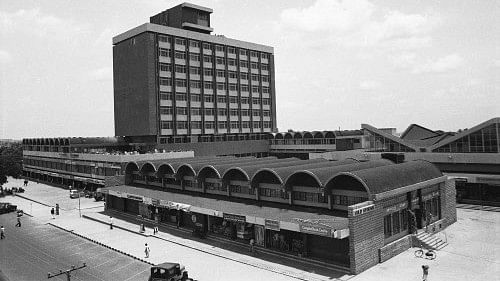
Jayanagar Shopping Complex.
Credit: DH File Photo
One of Bengauluru’s most well-planned neighbourhoods, Jayanagar, celebrated its diamond jubilee on Sunday.
Inaugurated on August 20, 1948, by then governor-general of India C Rajagopalachari, it remains one of Bengaluru’s greenest and most prestigious localities.
Jayanagar is an amalgamation of a cluster of villages, and it was developed by the City Improvement Trust Board (CITB).
“The locality was mostly surrounded by agricultural lands. These were all brought together by the CITB, the precursor of BDA, with the objective of creating a planned neighbourhood, with roundabouts and all that jazz,” says Yashaswini Sharma, author and architect. While the blueprint for the layout was inspired by the neighbouring locality of Basavanagudi, the idea was to create something better.
Initially, the layout had 5,750 sites and covered a lavish 1,262 acres, making it larger than any of the other planned neighbourhoods in the city — many claim Jayanagar was the largest planned layout in Asia at the time of its inception.
Meera Iyer, author of the book Discovering Bengaluru, elaborates on the reasons Jayanagar became such a success. “In terms of planning, one thing that stands out is the distribution of parks and open spaces. Compare it with earlier layouts such as Basavanagudi where there is one central, big, park, or Malleswaram where there was a large open space to its south and a series of small parks along one end. In Jayanagar, there was a conscious effort to distribute parks and gardens throughout.”
Farmland serenity
The wide roads, green spaces and the ‘art deco’ buildings remain an integral part of the neighbourhood to this day.
However, that wasn’t always the case, says A N Kumar Raju, president of Cosmopolitan Club. Born and raised in Thayappanahalli — currently known as 4th T Block in Jayanagar — the locality was earlier home to many agricultural families, he says.
“Thayappanahalli was a small village. There were about 20-25 small houses with tiled roofing and two big houses. The surrounding area was just empty grounds, farmlands and lakes. We had electricity, but no proper water connection. The roads were all mud roads. As Jayanagar developed, we got asphalt roads and other amenities,” recalls the 66-year-old. Reminiscing the “golden days”, Raju talks about the popular sports culture: “People from all around the city would come to play cricket in Jayanagar. We had many empty grounds and in almost all of them, you would find youngsters playing cricket or other sports. Today, these grounds have turned into stadiums such as the Kittur Rani Chennamma Stadium.”
Modern Jayanagar is no match for the neighbourhood in its early days, says Gayaatri Chandrashekar, 75. Her home in 3rd Block is one of the few remaining from the early days of the neighbourhood, she tells Metrolife.
“Earlier, it used to be completely residential. We used to have only one grocery store called Grant Store. With little vehicular movement, by 7.30 pm, there would be absolute silence. With today’s traffic, you can’t even imagine such serenity,” says the senior executive at DD News.
Another resident, Honganur Ahobala Rao Manohar, who moved to Jayanagar in 1960, says the Jayanagar Shopping Complex changed the entire locality. “We had never seen something like that before. It had an open layout and multiple stores. Over the years, we had to say goodbye to some of our favourite landmarks like Amba Bhavan in 3rd Block. They used to have the best khaali dosas,” he says.
Stories within Jayanagar
The layout was named after Jayachamarajendra Wadiyar, says social historian Dharmendra Kumar. “He took over as the maharaja in 1940, and in 1948, to commemorate eight years of his rule, he wanted Jayanagar to be created,” he says.
A landmark pays homage to a renowned engineer. Madhavan Park in 1st Block was named after R Madhavan, under whose leadership Jayanagar was built. “There are many interesting titbits about Jayanagar. The most popular one is about Ashoka Pillar, which Rajagopalachari unveiled during the inauguration. Back then, this pillar marked the erstwhile southern end of Bengaluru,” he adds.
Over the years, as Jayanagar developed, it caught the interest of real estate developers. “Also, there weren’t so many temples before. Take Ragigudda for example, earlier, there was no temple there, it used to be a picnic spot,” he tells Metrolife.
A piece of Balochistan
Gayathri Chandrashekar has an interesting fact to share about Jayanagar 3rd Block. “To many old-timers, this block is ‘Tareen Block’. Do you know why?” she asks.
“This part of Jayanagar early on belonged to a family from Balochistan. The family of Ghouse Khan Tareen, an official with the Imperial Police Force, lived here. His son Obeidulla went on to buy a lot of agricultural land across the city. He gave away some to his children, used some to build a mosque, and the rest of it he sold to the City Improvement Trust Board. Today, many popular landmarks like Rani Chennamma Stadium stand on this land. Hence the name ‘Tareen Block’,” she says.